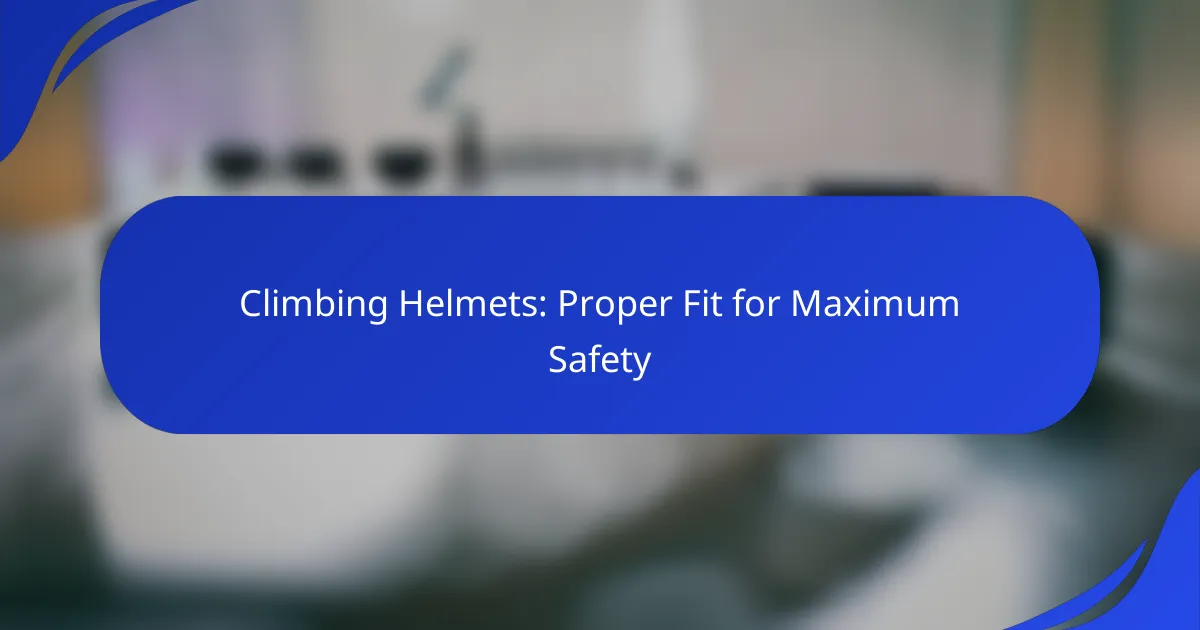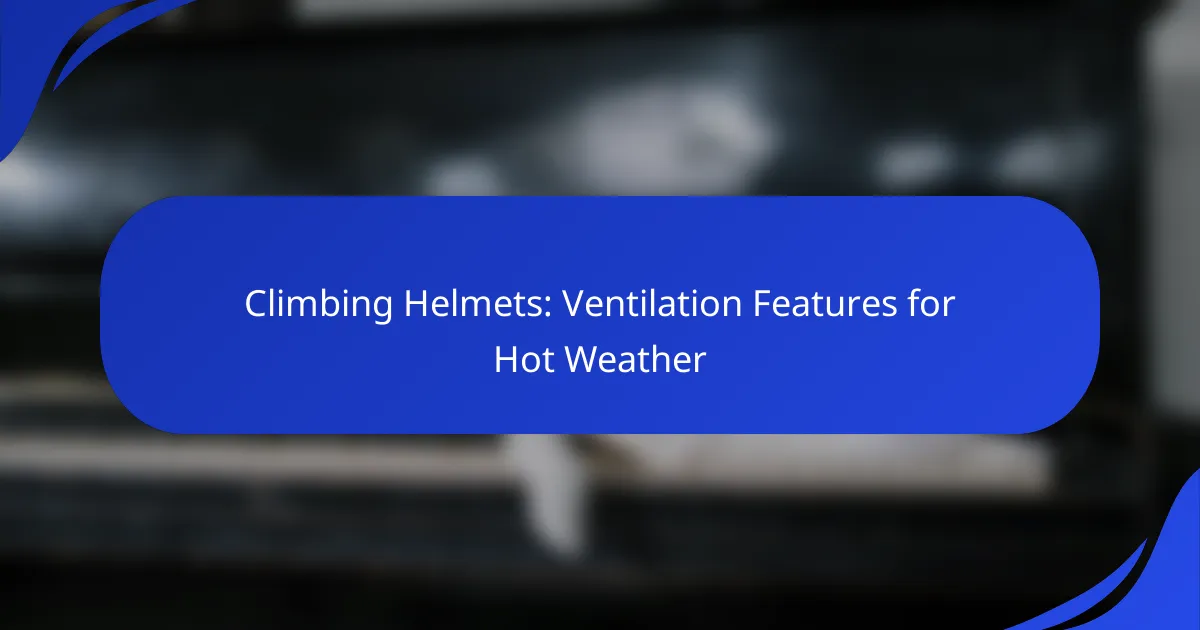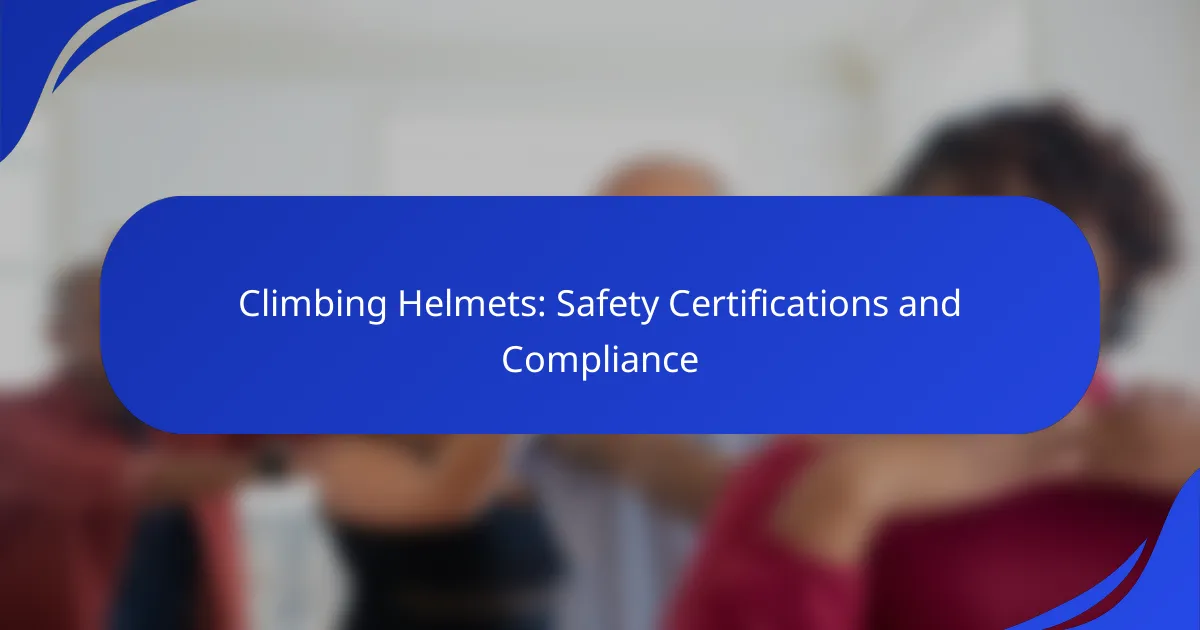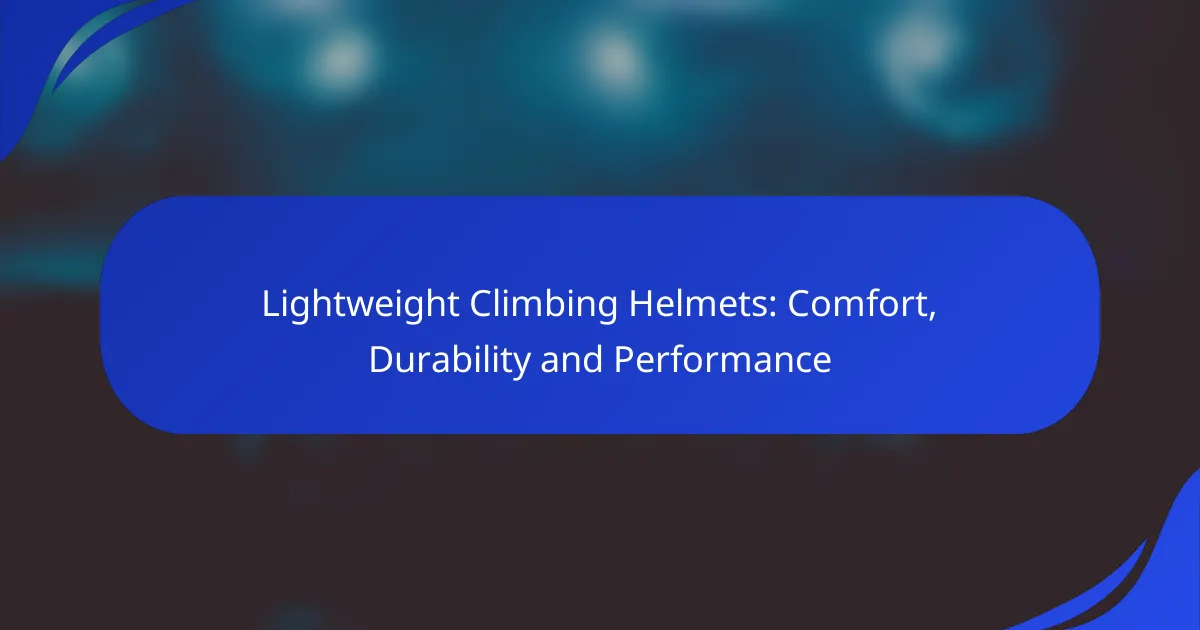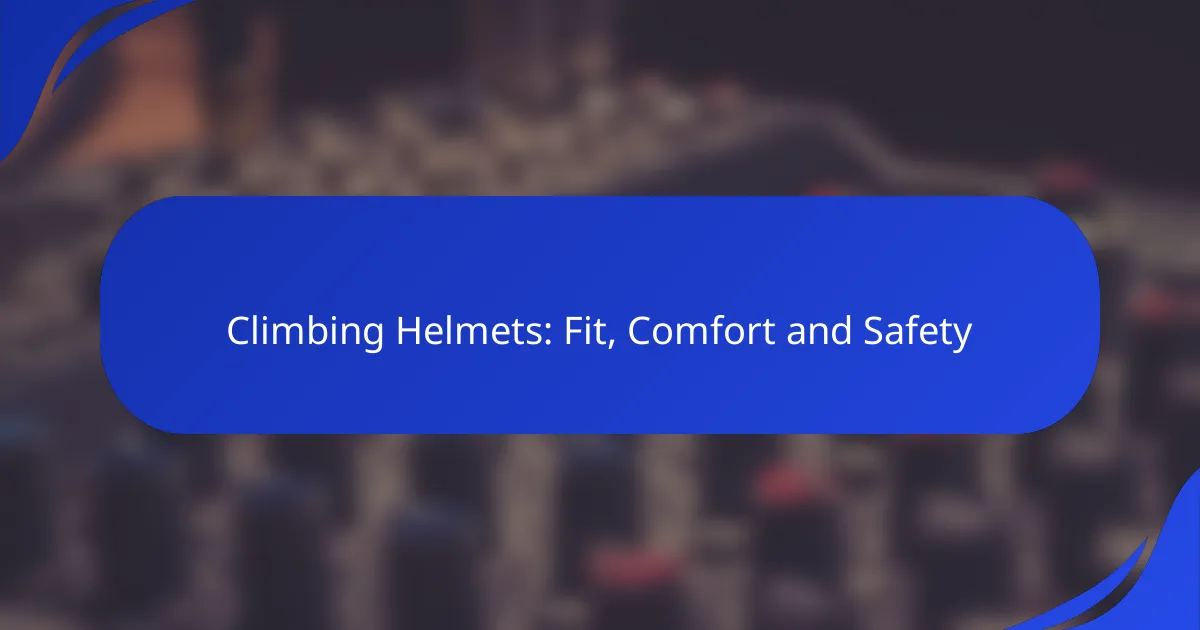Selecting the right climbing helmet is essential for ensuring safety while climbing. A proper fit enhances protection, comfort, and stability, significantly reducing the risk of injury during falls or impacts. To achieve this, it’s important to take accurate measurements of your head to ensure the helmet fits correctly.

How to choose the right climbing helmet for safety?
Selecting the right climbing helmet is crucial for ensuring safety while climbing. A proper fit not only enhances protection but also improves comfort and stability during climbs.
Consider head shape and size
Your head shape and size are fundamental when choosing a climbing helmet. Measure the circumference of your head just above the eyebrows to find your size, which typically ranges from small (around 50-54 cm) to large (58-62 cm). Additionally, consider the shape; some helmets fit round heads better, while others accommodate oval shapes.
Trying on different models can help you find the best fit. Ensure the helmet sits level on your head and does not rock back and forth. A snug fit is essential for safety, as a loose helmet can shift during a fall.
Check safety certifications
Safety certifications indicate that a climbing helmet meets specific safety standards. Look for helmets that comply with UIAA (International Climbing and Mountaineering Federation) or CE (European Conformity) standards, as these ensure the helmet has been tested for impact resistance and durability.
Always verify the certification label on the helmet. Avoid helmets that lack these certifications, as they may not provide adequate protection during climbing activities.
Evaluate weight and comfort
The weight of a climbing helmet affects your comfort during long climbs. Lighter helmets, typically weighing between 250-350 grams, are preferable for extended use, as they reduce fatigue. However, ensure that the lightweight design does not compromise safety features.
Comfort is equally important; look for helmets with padding and a comfortable chin strap. A well-padded helmet can significantly enhance your climbing experience by minimizing discomfort during prolonged wear.
Assess ventilation features
Ventilation is essential for maintaining comfort during climbs, especially in warm weather. Many helmets come with vents that allow airflow, helping to keep your head cool. Look for models with adjustable vents that can be opened or closed based on the weather conditions.
However, be aware that increased ventilation may slightly reduce impact protection. Balance your need for airflow with the helmet’s overall safety features to ensure optimal performance.
Look for adjustable fit systems
An adjustable fit system is crucial for achieving a secure and comfortable fit. Many climbing helmets feature dial or strap systems that allow for easy adjustments. This ensures that the helmet can be tightened or loosened as needed, accommodating different head shapes and sizes.
When trying on helmets, test the adjustment mechanism to ensure it operates smoothly. A good fit system will help keep the helmet in place during climbs, enhancing safety and comfort.

What are the benefits of a proper helmet fit?
A proper helmet fit ensures maximum safety while climbing by providing optimal protection, comfort, and stability. When a helmet fits correctly, it can significantly reduce the risk of injury during falls or impacts, making it an essential aspect of climbing gear.
Enhanced protection against impacts
A well-fitted helmet offers superior protection against impacts by ensuring that the helmet remains securely in place during a fall. This stability minimizes the risk of the helmet shifting or coming off, which can lead to serious head injuries. Look for helmets that meet safety standards such as EN 12492 or UIAA 106, which indicate reliable impact resistance.
To achieve a proper fit, adjust the chin strap and internal padding so that the helmet sits snugly on your head without excessive movement. Regularly check the fit, especially if you wear it over a beanie or headband, as this can affect how securely it sits.
Improved comfort during climbs
Comfort is crucial for long climbing sessions, and a properly fitting helmet can make a significant difference. A helmet that fits well distributes weight evenly across your head, reducing pressure points and discomfort. This allows climbers to focus on their performance rather than adjusting their gear.
When trying on a helmet, wear it for a few minutes to assess comfort levels. Look for features like adjustable ventilation and moisture-wicking liners that can enhance comfort during extended climbs.
Better stability in high winds
In windy conditions, a properly fitted helmet remains stable, preventing it from being blown off or shifting unexpectedly. This stability is vital for maintaining focus and safety while climbing in exposed areas. A helmet with a secure fit will help you avoid distractions caused by wind resistance.
To ensure stability, consider helmets with a low-profile design and a snug chin strap. Additionally, practice adjusting the fit before climbing in windy conditions to ensure that your helmet will stay in place when it matters most.

How do I measure my head for a climbing helmet?
To measure your head for a climbing helmet, you need to take a few simple measurements to ensure a proper fit. A well-fitted helmet is crucial for safety, as it protects your head during climbs and falls.
Use a flexible measuring tape
Start by obtaining a flexible measuring tape, which is ideal for wrapping around your head. If you don’t have one, a piece of string can work, but you’ll need to measure it against a ruler afterward. Ensure the tape is not too tight or too loose, as this will affect the accuracy of your measurement.
Measure around the forehead
Position the measuring tape around the widest part of your head, typically just above your eyebrows and ears. Make sure the tape is level and snug but not constricting. Record the measurement in centimeters or inches, depending on your preference.
Compare measurements with size charts
Once you have your measurement, compare it against the size charts provided by helmet manufacturers. Most brands categorize their helmets into small, medium, large, and extra-large sizes based on head circumference. If your measurement falls between two sizes, consider trying on both to find the best fit.

What are the top climbing helmet brands?
The leading climbing helmet brands include Petzl, Mammut, and Black Diamond, known for their commitment to safety, comfort, and innovative designs. Each brand offers a range of helmets that cater to different climbing styles and preferences, ensuring climbers can find the right fit for their needs.
Petzl climbing helmets
Petzl helmets are renowned for their lightweight construction and excellent ventilation, making them ideal for long climbs. They often feature adjustable headbands and chin straps for a secure fit, which is crucial for safety during falls.
Popular models like the Petzl Sirocco and Meteor are designed with impact resistance and comfort in mind. When choosing a Petzl helmet, consider the type of climbing you will be doing, as some models are more suited for sport climbing while others are better for mountaineering.
Mammut climbing helmets
Mammut helmets combine robust protection with a sleek design, focusing on both safety and aesthetics. Their models, such as the Wall Rider and Skywalker, are equipped with features like a removable headlamp holder and adjustable ventilation, enhancing usability in various conditions.
When selecting a Mammut helmet, pay attention to the fit and weight, as these factors can significantly affect your climbing experience. Many Mammut helmets meet international safety standards, ensuring reliable protection on the rock.
Black Diamond climbing helmets
Black Diamond helmets are designed for durability and performance, often favored by serious climbers. Models like the Half Dome and Vector offer a balance of protection and comfort, featuring adjustable sizing systems for a personalized fit.
Consider the specific features of Black Diamond helmets, such as their impact resistance and compatibility with climbing gear. These helmets are tested to meet industry safety standards, providing peace of mind while you tackle challenging routes.

How do I ensure my climbing helmet is properly adjusted?
To ensure your climbing helmet is properly adjusted, focus on achieving a snug fit that remains comfortable. A well-fitted helmet is crucial for maximum safety during climbs, as it protects your head from impacts and falls.
Adjust the chin strap for snugness
Start by adjusting the chin strap so that it fits snugly under your chin without causing discomfort. The strap should be tight enough to keep the helmet in place but not so tight that it restricts movement or breathing.
A good rule of thumb is to ensure you can fit one or two fingers between the strap and your chin. This balance helps maintain safety while allowing for some flexibility.
Check the fit with a shake test
Perform a shake test to confirm that your helmet is securely fitted. Put the helmet on and shake your head side to side and up and down. If the helmet shifts significantly or feels loose, readjust the straps.
The helmet should stay in place without excessive movement. If it slides around, you may need to tighten the chin strap or adjust the internal padding for a better fit.
Ensure the helmet sits level on the head
Position the helmet so that it sits level on your head, covering your forehead without tilting back or forward. The front of the helmet should be about one to two finger widths above your eyebrows to provide optimal protection.
Check in a mirror to ensure it looks straight and feels balanced. A helmet that is tilted can compromise safety by leaving parts of your head exposed to potential impacts.

What are the common mistakes when fitting a climbing helmet?
Common mistakes when fitting a climbing helmet include not securing it tightly enough and failing to adjust it for a proper fit. These errors can compromise safety and protection during climbing activities.
Wearing a helmet too loose
A climbing helmet that is too loose can shift during a fall, reducing its effectiveness in protecting your head. It may not absorb impact properly, leading to potential injuries.
To ensure a snug fit, adjust the chin strap and internal padding according to the manufacturer’s instructions. A good rule of thumb is that the helmet should sit level on your head and not move when you shake your head gently.
Check that the helmet does not slide down over your eyes or up off your forehead. If you can fit more than one finger between the helmet and your chin when the strap is secured, it is likely too loose and needs adjustment.






